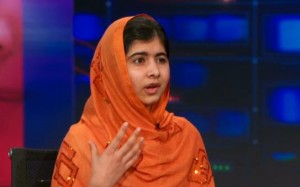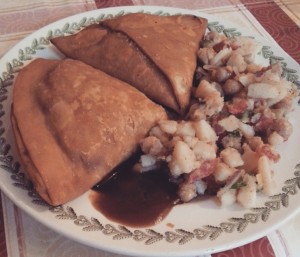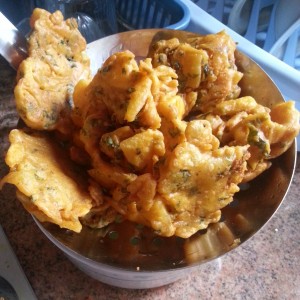Pakistan’s cultural currency — an example
 Next to other cultures, Pakistan’s culture is not ascending in the global marketplace. Quite the contrary. The most notable example of its global status in recent times is the commentary around Malala Yousafzai’s Nobel Prize win (and, to be quite honest, everything she’s done since recovering from being shot in the head by the Taliban): people claim that Malala is the ‘puppet of the west,’ people condemn her apparent refusal to critcize the UK or the US, people criticize her for aligning herself too much with the UK and the US, or not aligning herself with Pakistan, and so on in a similar, reductive vein.
Next to other cultures, Pakistan’s culture is not ascending in the global marketplace. Quite the contrary. The most notable example of its global status in recent times is the commentary around Malala Yousafzai’s Nobel Prize win (and, to be quite honest, everything she’s done since recovering from being shot in the head by the Taliban): people claim that Malala is the ‘puppet of the west,’ people condemn her apparent refusal to critcize the UK or the US, people criticize her for aligning herself too much with the UK and the US, or not aligning herself with Pakistan, and so on in a similar, reductive vein.
For the sake of argument, if Malala is conceivably a ‘puppet of the west’ it would be absolute foolishness to criticise the puppet for the puppet master’s actions. It is, however, a strong argument that Malala is being used as a tool of the west; her campaign for better education rights for women is framed within the narrative of a young woman escaping backwards Pakistan, a nation that doesn’t support women’s rights and other such freedoms. A narrative closer to the reality of the situation is that this is a 17-year-old girl who has given countless talks about her experiences, her hopes and beliefs; she doesn’t exist to provide a deconstruction of Islam’s place in the west. She is being used as a prop for the white saviour complex and a symbol for what the west is working towards in killing more Pakistani girls than the Taliban. She is more of a symbol than a person; her personhood is, indeed, trumped by the construction of her experiences as cultural currency for the western propaganda machine.
Talking about microaggressions without the inevitable ‘OMG who cares’

When discussing racist, imperialistic and colonial structures I find that one of the hardest things to talk about is the category of microinvalidation or microaggression. These are acts of racism which chip away at a person of colour’s sense of self and, while generally tolerable during everyday life, they are infuriating and damaging on a more general scale.
Microaggressions serve as a consistent, corrosive reminder of the racial hierarchies that privilege white people. One such example of microaggressions is that of Pakistani food going largely unrecognized in the UK, as well as being labelled ‘Indian food.’ This is not a criticism of Indian or Pakistani people, those respective countries or the quality of the food. This is about the reception and propagation of those two kinds of food. Given the fact that those two countries were partitioned into separate nations it is entirely understandable that there is going to be a significant overlap in terms of food evolution and development.
The labeling of a wide variety of food only as ‘Indian’ is just one such micro aggression of many. I’ve lived in the UK all my life and only once have I ever seen a food establishment calling itself ‘authentic Pakistani cuisine’. Even to say ‘two types of food’ is quite a stretch given the diversity of cuisines across the regions. However, the popularity of Indian food in the UK is such that it is fully integrated within British culture; ‘going for a curry’ is synonymous with ‘having an Indian’ and is a staple part of most people’s lives. Indian food in the UK is a prime example of cultural exchange, and not cultural appropriation (Everyday Feminism sums this up well, cultural exchange is respectful and contextual, not a costume as with cultural appropriation). Generally speaking, Indian food is well received in the UK and everything from small takeaways, middle-market restaurants and high-class restaurants are a sizable chunk of the food business here.
The problem with this cultural exchange is that more often than not Indian food (and culture) is placed, through hegemonic discourses, as the only form of South Asian culture. And here we reach the difficulty in communicating microaggressions and microinvalidations because the obvious question is: so what? Why does it matter? It’s still the same food and you know what it is, so just get over it.
Why it’s a problem
As I’ve said earlier, the history of the foundation of India and Pakistan, their proximity and their development into independent nations is one which has resulted in a permeable cultural border between the two. Establishments labeled as Indian cuisine have Pakistani and Indian people working in the kitchens so, bearing all these points in mind, it is hardly surprising that there is a significant level of cultural exchange and merging between the two nations. This, however, becomes significantly less tolerable when we compare the cultural capital of India against the cultural capital of Pakistan.

The prevalent cultural representation of India is that of Bollywood, the food, the Taj Mahal, saris and bindhis. Now, if you’re not South Asian what do you know about Pakistan’s culture? The terrorism? The Taliban? The political turmoil? The corruption? The poverty? I’m not saying that India is not represented as without poverty or corruption or political turmoil because both India and Indian people are constructed as ‘Other’ and thus subject to the same racist portrayals as Pakistani people.
The point I’m making here isn’t even about India and Pakistan directly. The point is about how Indian food and culture is received in the west, as opposed to Pakistani food and culture. It is a microaggression to have Pakistani food’s origin erased and overtly positioned as Indian; the cultural and symbolic capital that affords Pakistan something that isn’t terrorism is part of the structural racism and xenophobia directed at Pakistan, diasporic citizens and second- and third-generation Pakistani immigrants.
Are there differences?
Happily, Buzzfeed has published a list of 25 Pakistani Dishes Everyone Needs to Try and I highly recommend reading it, if only for the argument raging in the comments section about what constitutes Pakistani or Indian food with a number of people disbelievingly having some form of ‘BUT THIS IS INDIAN FOOD’ comment. Realistically, only generalizations about the difference between the two can be made; there will, of course, be dishes specific to certain areas, influences and interpretations across a range of areas but that’s an entirely different blog post. (A starting point on that particular discussion, however, is the Wikipedia pages for each nation’s cuisine — India’s covers 37 different regional variances in flavor whilst Pakistan’s recognizes the influences on pre- and post-partition Pakistan with a similar structure of regional variances.)
Pakistani food and culture can stand to get more recognition for their attributes; nothing is taken away from India, Indian culture or Indian people in just acknowledging that if the two countries have similar cuisines then some of it is going to have originated from Pakistan. Any such recommendation can only feed into the symbolism surrounding the country. Symbols and labels are important, but, even more so when representing the cultural capital and general knowledge of a minority community. It would only be fair and accurate to give Pakistan a piece of the roti.
* * *
Maryam Jameela lives in the UK and is currently preparing to begin her Ph.D. research at the University of Sheffield. You can follow her on Twitter at @yammatron and see other things she’s written here — where the original version of this post appears.













Bangladesh and Bangladeshi’s are a big part of the UK curry scene, but I don’t find any mention of them in this article. No Sri Lanka, Nepal, Bhutan, etc. either.
Can we say that the author is engaging in a bit of micro-agression or micro-invalidation herself?
When I was writing this post it did occur to me that I should mention Bangladesh specifically as well as other Desi countries that have contributed to the growth and development of curry in the UK. I didn’t actually follow through with that because I was too wrapped up in the experiences of Pakistani people. Thank you for pointing it out, and you’re absolutely right, it is a micro-aggression/invalidation for me to disregard those other experiences, I messed up.